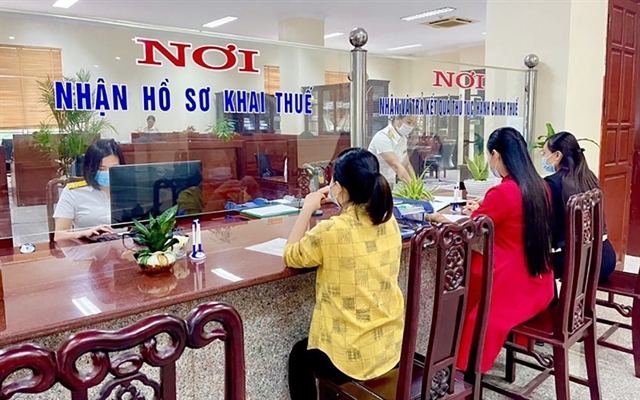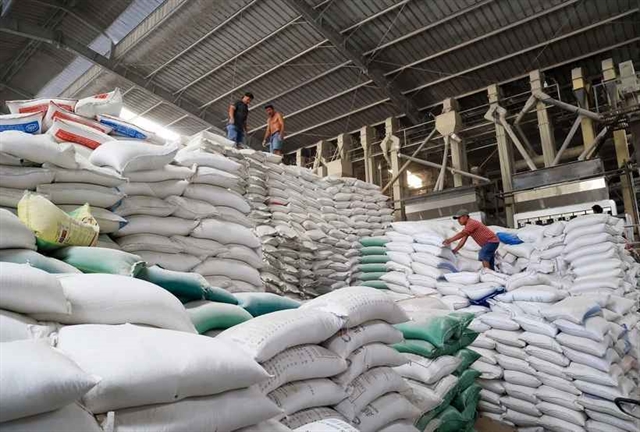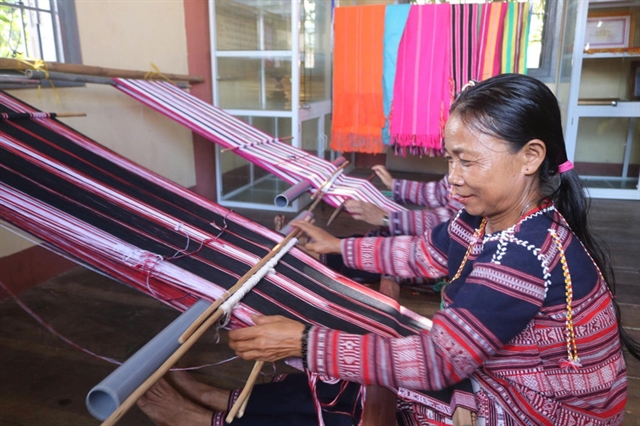 Economy
Economy


|
| An export rice warehouse of Dương Vũ Company in the southern province of Long An. VNA/VNS Photo |
HÀ NỘI — Political conflicts and climate change have continued to push up rice import demand in many markets, but Vietnamese rice exporters are very careful in choosing orders to minimise risks of unexpected price changes.
Phạm Thái Bình, chairman of Trung An High-Tech Agriculture Joint Stock Company, said factors such as political conflicts and climate change, which caused rice demand and rice prices to increase in 2023, are continuing in 2024. Therefore, the need to import and reserve food in general and rice in particular is continuing to increase this year, offering favourable conditions for Việt Nam's rice exports.
The European war has not ended yet while new conflicts have occurred, making the world situation even more unstable. Meanwhile, climate change is having a clear impact on agricultural producing countries as their food and rice production areas are shrinking, Bình said, adding that many countries have to increase rice imports and reserves to ensure food security.
It is forecast that in 2024, the world will face a shortage of about 5 million tonnes of rice, and India will likely continue to limit rice exports to keep domestic rice prices stable.
Right from the end of 2023 and early 2024, many countries have promoted the search for rice supplies to import. Việt Nam's traditional rice import markets, such as the Philippines and Indonesia, all need to increase rice imports.
Phùng Văn Thành, Vietnam Trade Counsellor in the Philippines, said the Philippines' rice import demand is up to 3.5-4 million tonnes per year and Việt Nam is the largest rice supplier for the country.
Vietnamese rice has certain advantages in the Philippine market as its quality is suitable for many consumer segments, from poor to high-income people, while its price is quite competitive, Thành said, adding that Vietnamese rice exporters have also had long-term trading relationships and built a good reputation with import partners in the Philippines.
Besides, Thành said, Việt Nam is geographically closer to the Philippines than some other rice exporting countries, which helps Vietnamese rice exports to the market have a short shipping time and lower shipping cost.
According to Thành, the rice market space in the Philippines is still large for Vietnamese exporters to further exploit. The current problem is how to build a brand and identity for Vietnamese rice so that many Filipinos know they are using Vietnamese rice. In fact, although significant amounts of Vietnamese rice have been exported to the Philippines recently, much is sold without Vietnamese brand names and the packaging only has a very small line stating Vietnamese origin.
Indonesia, another large rice importer of Việt Nam, is also forecast to increase imports by about 600,000 tonnes in 2024. In addition, China and Africa's rice import demand is also forecast to increase this year.
Sharing the same view, Nguyễn Vĩnh Trọng, General Director of Viet Hung Limited Liability Company, said with the escalating war situation in some regions combined with the negative impacts of climate change, food security is becoming a major concern for many countries. Therefore, it is forecast that world rice prices will continue to be high in the near future. Việt Nam is an agricultural producing country with advantages in the rice industry, so it should seize the opportunity to increase export value to ensure profits for both rice farmers and exporters.
Nguyễn Việt Anh, General Director of Phương Đông Food Company Limited, said in the first and second quarters of 2024, world rice demand will be still high, but it is not easy for rice exporters to sign export contracts and they have to continually monitor market developments. Anh explained with the current high rice price, rice exporters will face many potential risks if they buy rice for reserve. However, if they don’t do that, they will not have rice to sell for the next crop.
According to Anh, rice exporters are cautious in this decision, as they had a lesson in 2023 when large price fluctuations caused the rice supply chain to break and many domestic rice suppliers did not deliver rice to them according to previously signed contracts, while they still had to deliver rice to foreign partners. At that time, to have rice delivered to the partners, domestic rice exporters were forced to buy rice from the local market at high prices and suffered losses.
According to industry insiders, India's decision to stop rice exports has been among key factors causing the world rice market to heat up. Meanwhile, India currently has made no clear move on whether it will continue the ban or resume rice exports. In case the country has enough food reserves, it is likely to export again, and the abundant world rice supply will cause rice prices to drop quickly. Therefore, rice exporters will certainly suffer losses or even go bankrupt if they buy rice to reserve at the current high price.
Bình said many customers currently ask to buy rice but there are almost no transactions because Vietnamese rice exporters have no more rice to sell.
Currently, the price of paddy at the field is very high at VNĐ10,000-10,500 per kg. With this high price, rice exporters will not dare to sign contracts with long delivery time, for fear of price fluctuations. Rice exporters currently sell right after buying and do not reserve much rice to avoid potential risks, Bình said. — VNS




